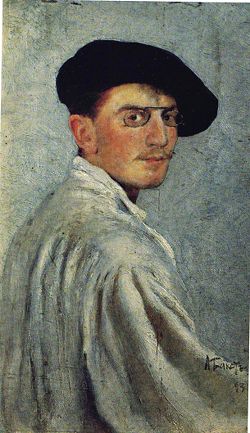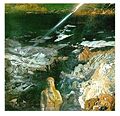Difference between revisions of "Leon Bakst" - New World Encyclopedia
(import Leon Bakst) |
(fix) |
||
| Line 1: | Line 1: | ||
[[Image:Bakst self.JPG|thumb|250px|right|Self-portrait]] | [[Image:Bakst self.JPG|thumb|250px|right|Self-portrait]] | ||
| − | '''Léon Samoilovitch Bakst''' ( | + | '''Léon Samoilovitch Bakst''' (May 10, 1866 - December 28,1924) was a [[Russia]]n [[Painting|painter]] and scene- and [[costume design]]er who revolutionized the arts he worked in. Born as '''Lev (Leib) Rosenberg''', he was also known as '''Leon (Lev) Nikolayevich Bakst''' (Леон (Лев) Николаевич Бакст). "Bakst" is his pseudonym derived from his grandmother's family name, Bakster ([[Baxter]]). |
==Early life== | ==Early life== | ||
Leon was born in [[Grodno]] (currently [[Belarus]]) in a middle-class [[Jewish]] family. After graduating from [[gymnasium (school)|gymnasium]], he studied in [[Imperial Academy of Arts|St. Petersburg Academy of Arts]] as a noncredit student, working part-time as a book illustrator. | Leon was born in [[Grodno]] (currently [[Belarus]]) in a middle-class [[Jewish]] family. After graduating from [[gymnasium (school)|gymnasium]], he studied in [[Imperial Academy of Arts|St. Petersburg Academy of Arts]] as a noncredit student, working part-time as a book illustrator. | ||
| − | On his first exhibition (1889) he took the name of ''Bakst'' based on his maternal grandmother's family name Baxter. At the beginning of the 1890s he exhibited his works with ''Society of [[watercolour]]ists''. | + | On his first exhibition (1889) he took the name of ''Bakst'' based on his maternal grandmother's family name Baxter. At the beginning of the 1890s he exhibited his works with ''Society of [[watercolour]]ists''. During 1893 - 1897 he lived in [[Paris]], where he studied at the [[Académie Julian]] while still visiting [[Saint Petersburg]] often. After the mid-1890s he became a member of the circle of [[writer]]s and [[artist]]s formed by [[Sergei Diaghilev]] and [[Alexandre Benois]], which later became the [[Mir Iskusstva]] art movement. |
In 1899, he co-founded with [[Sergei Diaghilev]] the influential periodical ''[[Mir Iskusstva|World of Art]]''. His graphics for the ''World of Art'' magazine brought him fame. | In 1899, he co-founded with [[Sergei Diaghilev]] the influential periodical ''[[Mir Iskusstva|World of Art]]''. His graphics for the ''World of Art'' magazine brought him fame. | ||
| Line 29: | Line 29: | ||
Image:Bakst Uzhin.jpg|Supper. 1902 | Image:Bakst Uzhin.jpg|Supper. 1902 | ||
Image:Leon Bakst - Model.jpg|Model, 1905 | Image:Leon Bakst - Model.jpg|Model, 1905 | ||
| − | Image:Bakst bely.jpg|[[Andrei Bely]], | + | Image:Bakst bely.jpg|[[Andrei Bely]], 1905 |
Image:Bakst Gippius.JPG|[[Zinaida Gippius]], 1906 | Image:Bakst Gippius.JPG|[[Zinaida Gippius]], 1906 | ||
Image:Bakst Elisium.jpg|Elisium, 1906 | Image:Bakst Elisium.jpg|Elisium, 1906 | ||
| Line 35: | Line 35: | ||
Image:Zharptitsa.jpg|Costume of Cléopatre for Ida Rubinstein1909 | Image:Zharptitsa.jpg|Costume of Cléopatre for Ida Rubinstein1909 | ||
Image:Léon Bakst 001.jpg|[[The Firebird]], Ballet costume 1910 | Image:Léon Bakst 001.jpg|[[The Firebird]], Ballet costume 1910 | ||
| − | Image:Bakst Nizhinsky.jpg|[[Vaslav Nijinsky|Nijinsky]] in the ballet [[Afternoon of a Faun (ballet)|L'après-midi d'un faune]] | + | Image:Bakst Nizhinsky.jpg|[[Vaslav Nijinsky|Nijinsky]] in the ballet [[Afternoon of a Faun (ballet)|L'après-midi d'un faune]] 1912 |
</gallery> | </gallery> | ||
Revision as of 00:48, 13 August 2008
Léon Samoilovitch Bakst (May 10, 1866 - December 28,1924) was a Russian painter and scene- and costume designer who revolutionized the arts he worked in. Born as Lev (Leib) Rosenberg, he was also known as Leon (Lev) Nikolayevich Bakst (Леон (Лев) Николаевич Бакст). "Bakst" is his pseudonym derived from his grandmother's family name, Bakster (Baxter).
Early life
Leon was born in Grodno (currently Belarus) in a middle-class Jewish family. After graduating from gymnasium, he studied in St. Petersburg Academy of Arts as a noncredit student, working part-time as a book illustrator.
On his first exhibition (1889) he took the name of Bakst based on his maternal grandmother's family name Baxter. At the beginning of the 1890s he exhibited his works with Society of watercolourists. During 1893 - 1897 he lived in Paris, where he studied at the Académie Julian while still visiting Saint Petersburg often. After the mid-1890s he became a member of the circle of writers and artists formed by Sergei Diaghilev and Alexandre Benois, which later became the Mir Iskusstva art movement.
In 1899, he co-founded with Sergei Diaghilev the influential periodical World of Art. His graphics for the World of Art magazine brought him fame.
Rise to fame
He continued easel painting as well producing portraits of Filipp Malyavin (1899), Vasily Rozanov (1901), Andrei Bely (1905), Zinaida Gippius (1906). He also worked as an art teacher for children of Grand Duke Vladimir Alexandrovich. In 1902 he took a commission from Tsar Nicholas II to paint Meeting of Russian sailors in Paris.
In 1898 he showed his works in the Diaghilev-organized First exhibition of Russian and Finnish Artists; in World of Art exhibitions, as well as the Munich Secession, exhibitions of the Union of Russian Artists, etc.
During the Russian Revolution of 1905 Bakst worked for magazines Zhupel, Adskaja Pochta, Satyricon, then for art magazine Apollon.
Stage design
Beginning in 1909 Bakst worked mostly as a stage-designer, designing sets for Greek tragedies, and in 1908 made a name as a scene-painter for Diaghilev with the Ballets Russes (Cleopatra (1909), Scheherazade (1910), Carnaval (1910), Narcisse (1911), Le Spectre de la rose (1911), Daphnis et Chloé (1912)). All that time he lived in Europe because as a Jew he did not have the right to live permanently outside the Pale of Settlement.
During his visits to Saint Petersburg he taught in Zvantseva's school. One of his students was Marc Chagall (1908-1910). In 1910 they broke. Bakst advised Chagall not to go to Paris as, according to Bakst, it would be harmful for Chagall's art and financially would probably cause him to die of starvation. Chagall moved there anyway, did not die and actually found his style.
In 1914 Bakst was elected a member of the Imperial Academy of Arts.
In 1922 he broke his relationship with Diaghilev and the Ballets Russes. He died in 1924 in Paris from lung problems.
Selected works
Andrei Bely, 1905
Zinaida Gippius, 1906
Nijinsky in the ballet L'après-midi d'un faune 1912
External links
- Ëåâ Áàêñò-áèîãðàôèÿ at www.silverage.ru (in Russian)
- BAKST at www.rollins.edu
- Leon Bakst (1866 - 1924) Artwork Images, Exhibitions, Reviews at wwar.com
- Works by Leon Bakst at the Russian Art Gallery
- Léon Bakst - A Virtual Gallery
Sources
- Marc Chagall, My Life, St.-Petersburg, Azbuka, 2000, ISBN 5-267-00200-3
Credits
New World Encyclopedia writers and editors rewrote and completed the Wikipedia article in accordance with New World Encyclopedia standards. This article abides by terms of the Creative Commons CC-by-sa 3.0 License (CC-by-sa), which may be used and disseminated with proper attribution. Credit is due under the terms of this license that can reference both the New World Encyclopedia contributors and the selfless volunteer contributors of the Wikimedia Foundation. To cite this article click here for a list of acceptable citing formats.The history of earlier contributions by wikipedians is accessible to researchers here:
The history of this article since it was imported to New World Encyclopedia:
Note: Some restrictions may apply to use of individual images which are separately licensed.










